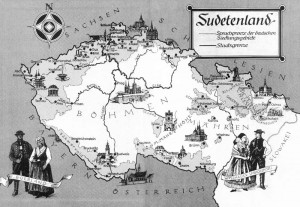 The districts of Czechoslovakia across the border from Germany and Austria were named after the Sudeten Mountains that run along the northern Bohemian frontier. The term Sudetenland came into use just after World War I by the ethnic Germans living in these areas. This map shows the larger concentrations of German speakers in the Czechoslovak Republic. Click the image to enlarge.
The districts of Czechoslovakia across the border from Germany and Austria were named after the Sudeten Mountains that run along the northern Bohemian frontier. The term Sudetenland came into use just after World War I by the ethnic Germans living in these areas. This map shows the larger concentrations of German speakers in the Czechoslovak Republic. Click the image to enlarge.
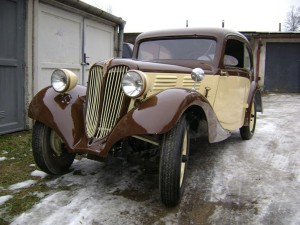 The Praga Baby is the civilian vehicle driven by Czechoslovak intelligence agents Burda and Furst. Voted the most elegant small car at the 1934 Berlin Car Show, the Baby was equipped with a 22hp four-cylinder four-stroke engine, as well as a three-speed fully synchronized gearbox, four-wheel independent suspension, and a top speed of 60 miles per hour. The two-door hardtop was produced in the most numbers.
The Praga Baby is the civilian vehicle driven by Czechoslovak intelligence agents Burda and Furst. Voted the most elegant small car at the 1934 Berlin Car Show, the Baby was equipped with a 22hp four-cylinder four-stroke engine, as well as a three-speed fully synchronized gearbox, four-wheel independent suspension, and a top speed of 60 miles per hour. The two-door hardtop was produced in the most numbers.
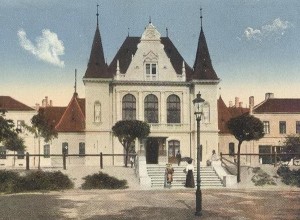 The Košice railway station in Slovakia was constructed during 1860 in a blending of romantic and gothic styles. The station was on the major east-west rail corridor in Czechoslovakia, as well as the major link south to Miskolc in Hungary. The station building continued in service into the 1970s when it was replaced.
The Košice railway station in Slovakia was constructed during 1860 in a blending of romantic and gothic styles. The station was on the major east-west rail corridor in Czechoslovakia, as well as the major link south to Miskolc in Hungary. The station building continued in service into the 1970s when it was replaced.
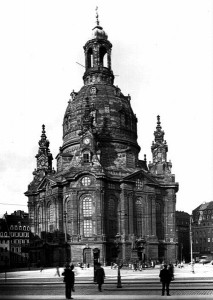 The Frauenkirche (Church of Our Lady) is a Lutheran parish church near the Elbe River in Dresden, Germany that was completed in 1743. The church was built in the Baroque style and featured one of the largest domes in Europe. The 315 foot-high dome was made of sandstone and weighed 12,000 tons. The observation platform near the top has a commanding view of the entire city.
The Frauenkirche (Church of Our Lady) is a Lutheran parish church near the Elbe River in Dresden, Germany that was completed in 1743. The church was built in the Baroque style and featured one of the largest domes in Europe. The 315 foot-high dome was made of sandstone and weighed 12,000 tons. The observation platform near the top has a commanding view of the entire city.
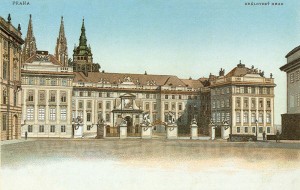 Prague Castle (Pražský hrad) in the city’s Hradčany district has served as both the official office and personal residence of Czech presidents since independence was declared in 1918. A medieval fort was built at the location in the year 880, followed soon after by several churches. As more structures were added over the years the site became the seat of power for Bohemia’s rulers during the 10th Century. Over such a long period the castle has been expanded, rebuilt and renovated many times. As a result many architectural styles are visible including Romanesque, Gothic, Renaissance, Baroque and Neoclassical.
Prague Castle (Pražský hrad) in the city’s Hradčany district has served as both the official office and personal residence of Czech presidents since independence was declared in 1918. A medieval fort was built at the location in the year 880, followed soon after by several churches. As more structures were added over the years the site became the seat of power for Bohemia’s rulers during the 10th Century. Over such a long period the castle has been expanded, rebuilt and renovated many times. As a result many architectural styles are visible including Romanesque, Gothic, Renaissance, Baroque and Neoclassical.
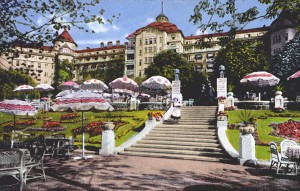 The Hotel Imperial was built to cater to wealthy patrons from across the world seeking the curative mineral waters found in Karlsbad (Karlovy Vary). At the time the hotel opened in 1912, 70,000 people were visiting the community every year. Constructed on the Helenin dvůr (Helenenhof) plateau above the city, two funicular railways were built through the hills to transport hotel guests between Karlsbad and the Imperial. In 1912 the hotel possessed over 300 rooms and salons with 100 spa rooms. Surrounding the Imperial were gardens and terraces occupying 35,000 square meters. The Hotel Imperial is still in operation today.
The Hotel Imperial was built to cater to wealthy patrons from across the world seeking the curative mineral waters found in Karlsbad (Karlovy Vary). At the time the hotel opened in 1912, 70,000 people were visiting the community every year. Constructed on the Helenin dvůr (Helenenhof) plateau above the city, two funicular railways were built through the hills to transport hotel guests between Karlsbad and the Imperial. In 1912 the hotel possessed over 300 rooms and salons with 100 spa rooms. Surrounding the Imperial were gardens and terraces occupying 35,000 square meters. The Hotel Imperial is still in operation today.
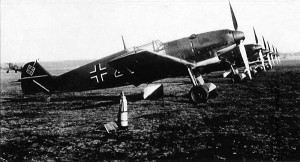 The Bf 109D was the most numerous German front-line fighter in September 1938 with more than 300 in service. Equipped with a Junkers Jumo 210D liquid-cooled 12-cylinder engine, the fighter had a top speed of 273 mph at 19,685 feet. Armament was two 7.92 mm MG 17 machine guns in the wings, plus another two MG 17s mounted on the nose and firing through the two-blade metal propeller. With an 89-gallon fuel tank capacity, the 671hp engine managed a maximum range of 280 miles.
The Bf 109D was the most numerous German front-line fighter in September 1938 with more than 300 in service. Equipped with a Junkers Jumo 210D liquid-cooled 12-cylinder engine, the fighter had a top speed of 273 mph at 19,685 feet. Armament was two 7.92 mm MG 17 machine guns in the wings, plus another two MG 17s mounted on the nose and firing through the two-blade metal propeller. With an 89-gallon fuel tank capacity, the 671hp engine managed a maximum range of 280 miles.
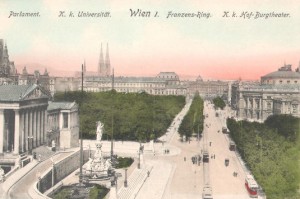 The Ring Road is a circular thoroughfare that surrounds the Innere Stadt district of Wien (Vienna). Late in 1857, Emperor Franz Josef I decreed that the old ramparts that encircled the inner city were obsolete and should be torn down. In their place he ordered a wide new boulevard to be constructed that would be accompanied by ample green areas and parks. The Emperor also laid out opulent new public structures to be built along the ring. The entire project was intended as a way to show off the glory and splendor of the Habsburg Empire. Construction was not completed until 1913. Some of the major buildings include the Academy of Fine Arts, Burgtheater, Museum of Art History, Museum of Natural History, Palace of Justice, Parliament, Rathaus and the University of Vienna.
The Ring Road is a circular thoroughfare that surrounds the Innere Stadt district of Wien (Vienna). Late in 1857, Emperor Franz Josef I decreed that the old ramparts that encircled the inner city were obsolete and should be torn down. In their place he ordered a wide new boulevard to be constructed that would be accompanied by ample green areas and parks. The Emperor also laid out opulent new public structures to be built along the ring. The entire project was intended as a way to show off the glory and splendor of the Habsburg Empire. Construction was not completed until 1913. Some of the major buildings include the Academy of Fine Arts, Burgtheater, Museum of Art History, Museum of Natural History, Palace of Justice, Parliament, Rathaus and the University of Vienna.
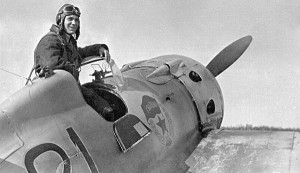 The air force in the Union of Soviet Socialist Republics was called Voenno-Vozdushnye Sily (V-VS). That name translated literally into Military Air Forces, although western newswire services popularized the term Red Air Force instead. In 1938 the V-VS was organized in a similar manner as ground units with air armies, aviation corps, aviation divisions, aviation regiments and aviation squadrons. As the Soviets were quite secretive about the number of aircraft they had deployed, estimates can vary significantly. The Associated Press reported at the time that sources in Germany estimated the V-VS had 10,000 combat-ready aircraft in 1938 (including Soviet Naval Aviation), while sources in Washington D.C. put the number closer to 7,000.
The air force in the Union of Soviet Socialist Republics was called Voenno-Vozdushnye Sily (V-VS). That name translated literally into Military Air Forces, although western newswire services popularized the term Red Air Force instead. In 1938 the V-VS was organized in a similar manner as ground units with air armies, aviation corps, aviation divisions, aviation regiments and aviation squadrons. As the Soviets were quite secretive about the number of aircraft they had deployed, estimates can vary significantly. The Associated Press reported at the time that sources in Germany estimated the V-VS had 10,000 combat-ready aircraft in 1938 (including Soviet Naval Aviation), while sources in Washington D.C. put the number closer to 7,000.
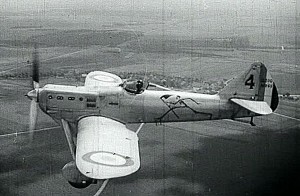 The most advanced French fighter in service during 1938 with the Armée de l’Air was the Dewoitine D.510. As the final version of an original design that first flew in service during 1934, the D.510 was equipped with an Hispano-Suiza 12Ycrs liquid-cooled 12-cylinder engine. The fighter had a top speed of 244 mph at 16,405 feet. Armament was two 7.5mm MAC 1934 machine guns in the wings, plus one 20 mm Hispano-Suiza HS.9 cannon firing through the hub of the three-bladed metal propeller. With a 91-gallon fuel tank capacity, the 860hp engine managed a maximum range of 435 miles.
The most advanced French fighter in service during 1938 with the Armée de l’Air was the Dewoitine D.510. As the final version of an original design that first flew in service during 1934, the D.510 was equipped with an Hispano-Suiza 12Ycrs liquid-cooled 12-cylinder engine. The fighter had a top speed of 244 mph at 16,405 feet. Armament was two 7.5mm MAC 1934 machine guns in the wings, plus one 20 mm Hispano-Suiza HS.9 cannon firing through the hub of the three-bladed metal propeller. With a 91-gallon fuel tank capacity, the 860hp engine managed a maximum range of 435 miles.
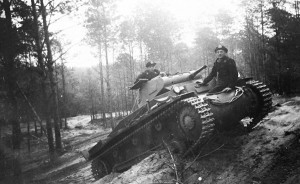 By the fall of 1938 the most numerous tanks in Wehrmacht service by far were light tanks such as the PzKpfw II. The main battle tank was supposed to be the Mark III, which had yet to enter service. The larger Mark IV was intended for infantry support and was available in small numbers. Early models of the PzKpfw II that were available against Czechoslovakia were designed with 14mm armor intended to withstand light infantry arms not anti-tank cannons. The main gun was a 20mm KwK 30 L/55 autocannon that used 10-round magazines but could fire 600 rounds per minute. There also was a 7.92mm Maschinengewehr 34 machine gun mounted in the turret. The six-cylinder Maybach HL 62 engine moved the 7.6 ton tank to a maximum speed of 25 miles an hour. The PzKpfw II had a three-man crew.
By the fall of 1938 the most numerous tanks in Wehrmacht service by far were light tanks such as the PzKpfw II. The main battle tank was supposed to be the Mark III, which had yet to enter service. The larger Mark IV was intended for infantry support and was available in small numbers. Early models of the PzKpfw II that were available against Czechoslovakia were designed with 14mm armor intended to withstand light infantry arms not anti-tank cannons. The main gun was a 20mm KwK 30 L/55 autocannon that used 10-round magazines but could fire 600 rounds per minute. There also was a 7.92mm Maschinengewehr 34 machine gun mounted in the turret. The six-cylinder Maybach HL 62 engine moved the 7.6 ton tank to a maximum speed of 25 miles an hour. The PzKpfw II had a three-man crew.
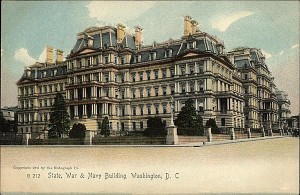 During the mid-1930s the home of the State Department of the United States was at State, War and Navy Building. The structure was built just west of the White House at 17th Street NW, between New York Avenue and Pennsylvania Avenue. Constructed in the French Second Empire style from 1871 to 1888, the building was designed for the War and Navy departments as well. Built of hand-hewn granite, the floors were laid with black slate and white marble squares, plus the interior benefited from huge skylights above the eight spiral staircases. By the time of the Sudetenland Crisis both the Navy and War departments had departed the building leaving the State Department as the sole occupant.
During the mid-1930s the home of the State Department of the United States was at State, War and Navy Building. The structure was built just west of the White House at 17th Street NW, between New York Avenue and Pennsylvania Avenue. Constructed in the French Second Empire style from 1871 to 1888, the building was designed for the War and Navy departments as well. Built of hand-hewn granite, the floors were laid with black slate and white marble squares, plus the interior benefited from huge skylights above the eight spiral staircases. By the time of the Sudetenland Crisis both the Navy and War departments had departed the building leaving the State Department as the sole occupant.
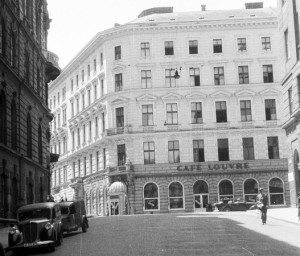 From the late 1920s onward the Café Louvre was the meeting place for Anglo-American journalists in Wien (Vienna). The café took up the first floor of the building at the corner of Wipplingerstrasse 27 and Renngasse 9, and had been operating there continuously since the last decade of the 19th Century. Interestingly enough, until the foreign correspondents made the establishment their own, it had been one of the primary meeting places of the city’s Jewish intellectuals and Zionists. No one knows the exact reason why reporters started meeting there but it is suspected that proximity to the Central Telegraph Office made Café Louvre a handy location to hang out at. Sending their articles via wire was one of the main ways journalists had to submit their material to their home bureaus.
From the late 1920s onward the Café Louvre was the meeting place for Anglo-American journalists in Wien (Vienna). The café took up the first floor of the building at the corner of Wipplingerstrasse 27 and Renngasse 9, and had been operating there continuously since the last decade of the 19th Century. Interestingly enough, until the foreign correspondents made the establishment their own, it had been one of the primary meeting places of the city’s Jewish intellectuals and Zionists. No one knows the exact reason why reporters started meeting there but it is suspected that proximity to the Central Telegraph Office made Café Louvre a handy location to hang out at. Sending their articles via wire was one of the main ways journalists had to submit their material to their home bureaus.
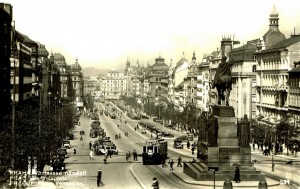 One of the most recognizable areas of Prague is Wenceslas Square (Václavské náměstí). Situated within the Nové Město (New Town) district of the city, the square dates back to the mid-14th Century and was the second largest market area until the late 19th Century. The square is 750 meters long with a statue of St. Wenceslas, the patron saint of the Czech lands, mounted on a horse at the southeastern entrance. The square is recognizable since it has long been a place where citizens in the capital assembled during critical times. In 1848 radical students and workers held a mass there against Austro-Hungarian rule that precipitated an uprising. Demonstrations for general voting rights took place in the square during 1905. In 1918 the proclamation establishing an independent Czechoslovakia was read before self-rule advocates at the statue of St. Wenceslas. When people flooded the streets in September 1938 to rally against capitulation to German demands it was Wenceslas Square where they headed to.
One of the most recognizable areas of Prague is Wenceslas Square (Václavské náměstí). Situated within the Nové Město (New Town) district of the city, the square dates back to the mid-14th Century and was the second largest market area until the late 19th Century. The square is 750 meters long with a statue of St. Wenceslas, the patron saint of the Czech lands, mounted on a horse at the southeastern entrance. The square is recognizable since it has long been a place where citizens in the capital assembled during critical times. In 1848 radical students and workers held a mass there against Austro-Hungarian rule that precipitated an uprising. Demonstrations for general voting rights took place in the square during 1905. In 1918 the proclamation establishing an independent Czechoslovakia was read before self-rule advocates at the statue of St. Wenceslas. When people flooded the streets in September 1938 to rally against capitulation to German demands it was Wenceslas Square where they headed to.
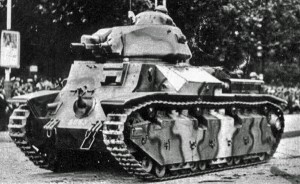 Developed in the early 1930s as insurance against the possible banning of a much heavier armor design by disarmament treaties under negotiation, 750 of the Renault D2 were initially ordered. When the treaty conference collapsed the D2 became less of a priority and only 100 were built between 1935 and 1940. Like all French tanks of the period the D2 was slow and had an inefficient one-man turret. The first 50 with a short-barreled 47mm SA34 cannon were assigned to the 507ème régiment de Chars de Combat in 1937. The regiment was based in Metz close to the Saar region of Germany where it trained in the use of tanks as a breakthrough weapon on the battlefield. The D2 had strong 40mm armor everywhere except the top and bottom of the hull. Along with its cannon the tank mounted two 7.5mm Châtellerault MAC 1931 machine-guns. The Renault V-6 engine moved the 19.4 ton tank to a maximum speed of 14 miles an hour. The D2 had a three-man crew
Developed in the early 1930s as insurance against the possible banning of a much heavier armor design by disarmament treaties under negotiation, 750 of the Renault D2 were initially ordered. When the treaty conference collapsed the D2 became less of a priority and only 100 were built between 1935 and 1940. Like all French tanks of the period the D2 was slow and had an inefficient one-man turret. The first 50 with a short-barreled 47mm SA34 cannon were assigned to the 507ème régiment de Chars de Combat in 1937. The regiment was based in Metz close to the Saar region of Germany where it trained in the use of tanks as a breakthrough weapon on the battlefield. The D2 had strong 40mm armor everywhere except the top and bottom of the hull. Along with its cannon the tank mounted two 7.5mm Châtellerault MAC 1931 machine-guns. The Renault V-6 engine moved the 19.4 ton tank to a maximum speed of 14 miles an hour. The D2 had a three-man crew
